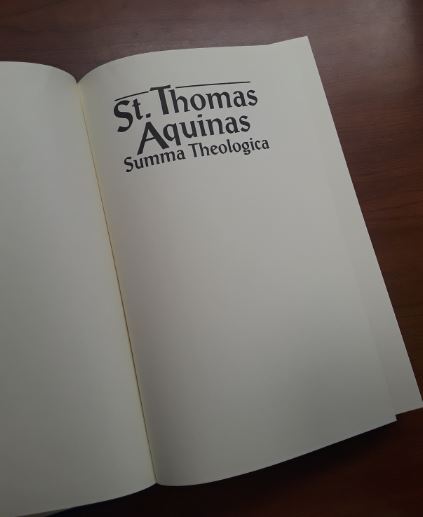Having struggled with this issue for some time, I thought I would attempt to get a final answer as to how Thomas Aquinas’s Summa Theologiæ* is to be cited in academic writing. What I discovered is that there seems to be no authoritative answer. This does not mean, however, that there are no wrong ways to do so. Below I present my findings (all subject to change as Thomists from around the blogosphere send in suggestions!).
Citing the Summa is based on its structure, so let’s begin with that.
The Summa has three main divisions called Parts:
- Part I (Prima Pars) deals with God
- Part II (Prima / Secunda Secundæ) is in two parts dealing with Humanity and Morality
- Part III (Tertia Pars) deals with Christ
Each Part is composed of Questions:
- Part I has 119 Questions
- Part II has 303 Questions total:
- The First Part of Part II has 114 Questions
- The Second Part of Part II has 189 Questions
- Part III has 99 Questions
Questions are dealt with in Articles, each made up of five sections:
- The topic of the article is given in the form a question.
- Plausible responses are listed as Objections (the adversus).
- A contrary response (reflecting Thomas’s thinking) from some authority is cited (indicated by sed contra – “On the contrary”).
- Thomas argues for his response [the respondeo – “I answer that” (aka corpus)].
- Brief replies are given to the initial objections.
When citing passages from the Summa, do not use page numbers (this would be like saying “Bible, p. 232”). Proper notation procedure is to list the above elements in a consistent manner; however, conventions vary widely (see academic examples below). So check with your school / professor for preferences, then just be consistent.
- Part Number
- First Part: “I” or “Ia”
- First Part of Second Part: “I-II” or “Ia-IIæ”
- Second Part of the Second Part: “II-II” or “IIa-IIæ”
- Third Part: “III” or “IIIa”
- **Supplement: “Suppl.” or “Suppl. IIIae”
- Question Number
- Article Number
- For a Reply to an objection, abbreviate adversus as “ad” followed by its number.
For those wanting to cite the prologue to a question or the subsections of an article within a question, the Latin text uses the following abbreviations:
- pr. — prologue to a question
- arg. — objections
- s. c. — “On the contrary”
- co. — “I respond that”
- ad. — replies to objections
Various Academic Citation Examples:
- Aquinas, ST I-II. Q12. A12.
- Sum I-II, 2, ii, ad. 1.
- ST I-II, Q. 3, Art. 2, ad. 1.
- ST I-II, Q 3, A 2, ad. 1.
- S.T. I-II, 2, ii, a.1.
- Ia.22.2
- Ia.I: 19, 34, 193(53)
- Ia. 3, 2 ad 3.
- 2a2ae. 180, 10. 3a 35, 8.
- Aquinas, Summa Theologica 1.65.4. (Footnote from Chicago Manual of Style 14.257 – “Identifying numbers in classical references”. For bibliography see “Editor, translator, or compiler in addition to author”).
Other Considerations:
- Although it is allowable to simply use “ae”, to make the “æ” character, in MS Word use character code 00E6 under INSERT, or, to make it in HTML type “æ” where “ae” would have gone (e.g., “Summa Theologiæ”).
- Thomas’s “last name” derives from his family’s place of origin in Aquino, Italy – so, Thomas of Aquino. Thus, his name is rendered Thomas D’Aquino in Italian (Thomæ Aquinatis in Latin means “of Thomas Aquinas”). For an English source citation or bibliography entry, his name is typically listed as “Aquinas, Thomas.” (Thanks to Prof. R. Howe for this insight!)
- Full bibliographic information on the Summa should only be included in its first citation and in the bibliography. After that, just use standard notation.
* The title of Aquinas’s work is Summa Theologiæ (Lt. for “Summary of Theology”), but it is sometimes titled Summa Theologica (e.g., NewAdvent.com and the popular Benziger Brothers 1947 translation). If you are not referencing a translation with “Theologica” in the title, stick with Summa Theologiæ.
**Aquinas never finished the Summa, but there is a Supplement compiled from his work on the Sentences attached to part three.




